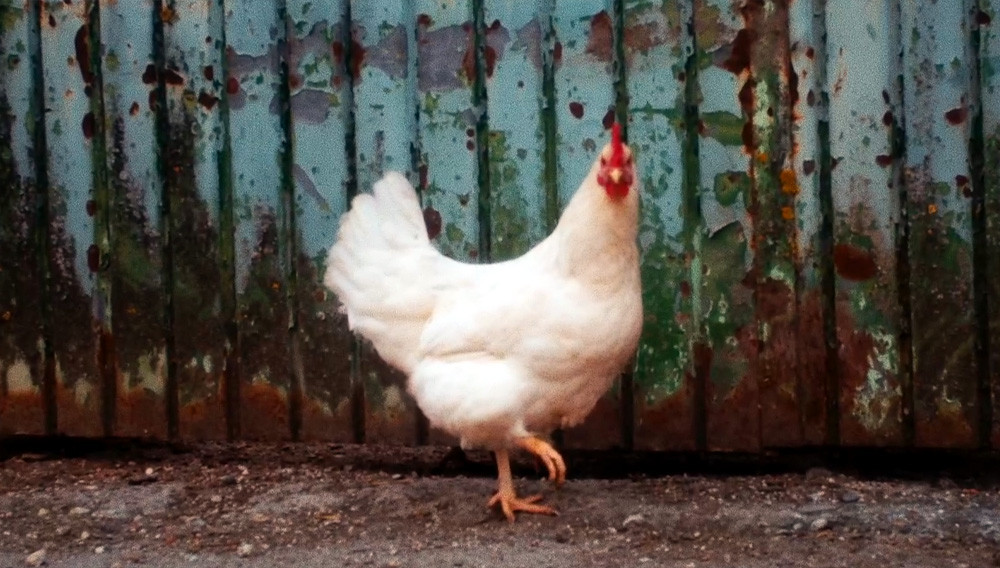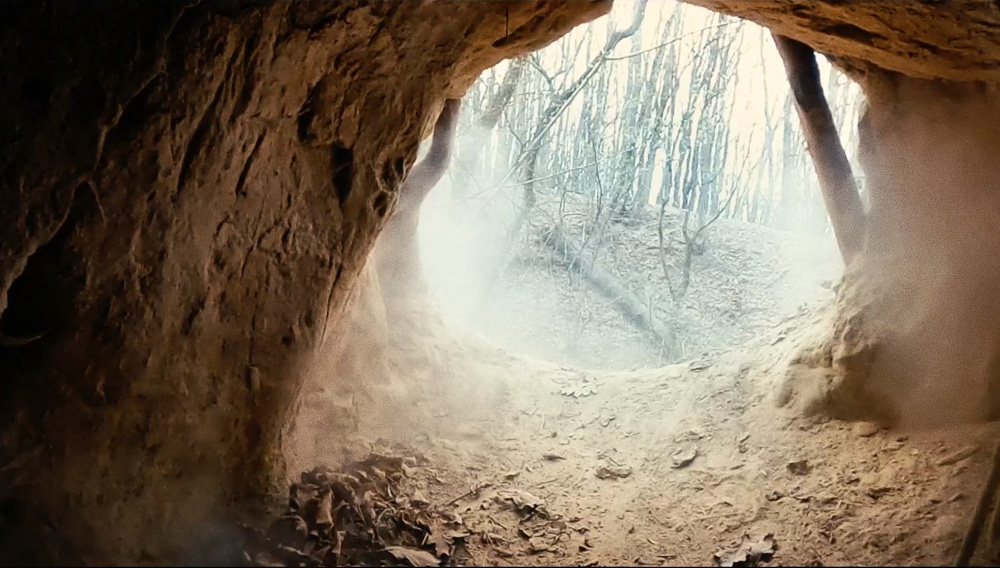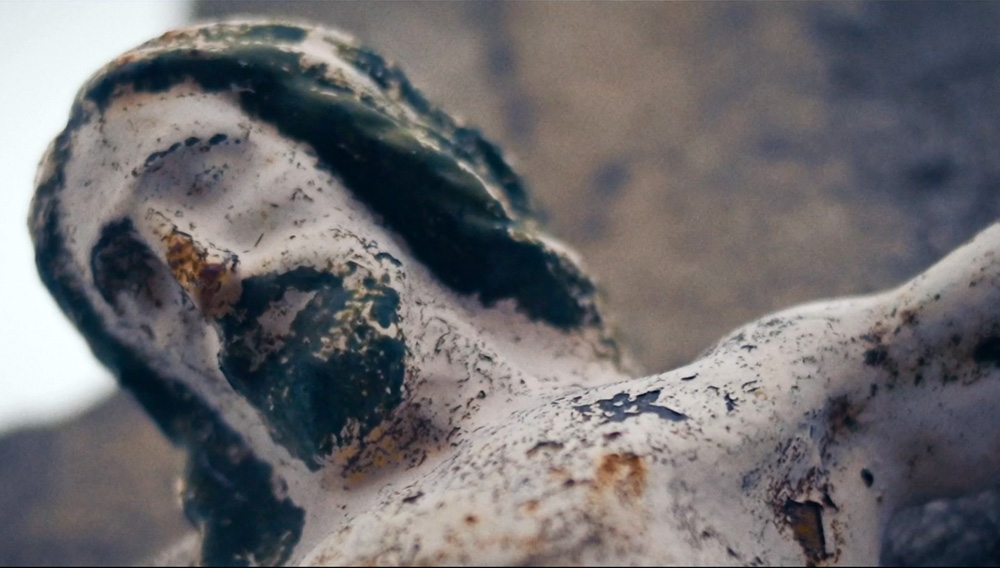Rogue artist, raconteur and cocktail roboticist Johannes Grenzfurthner is a Viennese Renaissance man whose obsessively detailed and cleverly unhinged films infiltrated some of North America’s more fun-oriented film festivals during the pandemic. Masking Threshold (2021) captured a descent into one man’s madness, using macro-photography and creative sound design to expand the visual style of YouTube videos while (unintentionally) nodding to the mental health decay suffered by many in lockdown. The new Razzennest, now streaming exclusively on Fandor, stages a faux-recording session of the commentary track for a found-footage documentary by a mysterious South African filmmaker. As haunting images reflect on the aftermath of the brutal Thirty Years’ War (1618 – 1648), irritable auteur Manus Oosthuizen clashes with effervescent critic Babette Cruickshank, their dialogue generously spoofing the American indie film scene—with shout-outs to some familiar names (including yours truly) and festivals—before things start going demonically haywire in the studio.
“I had to deal with the success of Masking Threshold, being at Fantastic Fest and suddenly having an American sales agent and a talent agent, all that stuff,” Grenzfurthner says, chatting during a Zoom call earlier this week. “It’s kind of my satirical take.” Razzennest also prioritizes dramatic elements of sound, which the filmmaker became obsessed with while working with designer Lenja Gathmann on the earlier feature, which among other things simulated the tinnitus that torments the protagonist. “That catapulted me right into Razzennest,” the Austrian auteur says, who worked with sound guys Daniel Hasibar and Fabian Wessely, “because I wanted to further explore what’s going on in that field.”
There’s much, much more going on behind the scenes of Grenzfurthner’s unique and twisted vision (which will become a loose trilogy with his upcoming Solvent), and he cheerfully leads the way deep into the rabbit hole—or, more fittingly, the “Swedish hole,” the name for the creepy caves featured prominently in the film—of his imagination.

You’ve been an artist for 30 years, but are a new name to American moviegoers, even the ones who have seen your films at idiosyncratic festivals like Fantastic Fest or Cucalorus. Can you introduce yourself?
There are a couple of super well-known things I did, but they are not super-connected to me because I did them as part of a group. Sometimes we even had fake names. I mean, we were the first people to bury people alive in an art context. So far, we’ve buried 500 people alive. You work anonymously sometimes because it’s easier to do it that way, because you don’t get arrested, but it’s not helpful in creating a brand for yourself.
Could you put your filmmaking into context with the rest of your art?
I made my first short film when I was 10 in the mid-’80s, with little space shuttles on wires that fly around. It’s even on YouTube. I got most of my knowledge about storytelling from watching movies. I read a lot, but I was way more into watching films and how they explain things or create characters. Even if it’s a theater project, something on the street, or the crazy prank projects I did, there’s always some kind of storytelling and somehow tied to filmmaking.
There’s a German term and, of course, it sounds like a war crime. It’s called volksbildung. I would translate it to “public education.” Always a part of me was a public educator. I know that people don’t read a lot of books. There are so many people that are clever, but they never got the proper education, or they were never introduced to certain concepts. But we know the culture of film. I don’t have to explain to my mother how film works. It’s such a mainstream medium, even independent films. More people see underground microbudget films than they see crazy art shows.
How would you describe monochrom, the artistic umbrella for your various activities?
We call it an “arts and theory group.” In March 1993, we published a ‘zine called monochrom. Over the first couple of years, it was only the ‘zine. But there is a glass ceiling for the reach of ‘zines. Then there was a Cambrian explosion when we said, “Hey, why not do a short film? Why not do a theater performance on the street? Why not do a computer game?” The core was trying to find the perfect weapon of mass distribution of an idea.
The rest of monochrom is us trying to do that: making a musical about an Austrian criminal, or we started a festival for cocktail robotics where we invite people to build machines that serve you cocktails. It’s an ironic twist about technological hype and marketing. We lure people to a cool event where robots give you alcohol, but we teach people that technology is no magic. You can learn to build your own, it’s easy, and we can help you do it yourself.

Razzennest takes the viewer on a wild ride that mixes satire, weird history and horror. As a filmmaker, you seem comfortable with the tension arising from that juxtaposition, although as you’ve noted about your Letterboxd reviews, it’s clearly not for everyone.
I’m working right now with a dramaturg who took one of my films and ripped it apart. I hate it because all the cool stuff has to be removed. I don’t want to work that way. The first thing he told me is “Never mix genres.” Nobody would want to watch if it doesn’t have the same rhythm all the time, and nobody will want to watch something that’s fun in the beginning and terrifies you in the end. People have an expectation, and they want their expectation fulfilled. I thought, “Oh shit, that’s exactly what I did with Razzennest,” because I wanted to do a satire that gradually shifts tonality and becomes a horror film. Of course, it doesn’t completely lose the comedy in the end, but it shifts from like 70% humor and 30% terror to 30% humor, 70% terror. He told me: “You should never do that.” Well, I just got a streaming release in the U.S. Now, what do you say?
What’s the story behind the “found footage” you shot for the film?
I watched a couple of arthouse films that became blueprints—specifically, one film that I have personal problems with. I hate it so much. There’s something about bad films. They leave something in you. There’s some residue of it still inside you. This film that I’m talking about is called Homo Sapiens by Nikolaus Geyrhalter, one of the bigger names in the Austrian art film scene.
Homo Sapiens is a 100-minute film. You never see a single person. It’s only rundown buildings, streets and shopping malls. It’s called Homo Sapiens because he wants to show a world after humans. That’s it. The entire film, no soundtrack, nothing. He should have done the coffee table book. There’s this one scene in this mall and there’s water dripping from the ceiling. Suddenly, a pigeon flies through. People started clapping in the audience because something was moving.
The classic example of “watching paint dry,” I guess? Where did you discover your version of the footage?
It’s pretty much all the things that the fake director says in his audio commentary track within the film. That’s all true. It was shot in an area called Rohrwald, which is half an hour by car outside of Vienna. “Rohr” means stick or cane, and “wald” is forest—so it’s kind of like “Cane Forest.” I have no idea where that comes from because there are no cane-like plants growing there. The Swedish holes and the Thirty Years’ War, all of that is true—the actual history of that area.
I remember when I was a kid, cycling there and ending up alone in the woods with those strange caves. There have been so many wars fought in the Rohrwald that it’s layer upon layer upon layer. The Thirty Years’ War that I’m talking about in Razzennest is only one of 100 wars that happened in 6,000 – 7,000 years of Central European history. I wanted to talk about it because I have this personal relationship to the Swedish caves, the stories I heard in elementary school. It was one of the bloodiest wars that has ever been fought in Europe. It’s still shaping politics made today.
It’s fun how you flip the dominance of sights and sounds. For me, dialogue often feels secondary to the image, but here you walk and chew gum at the same time, because the action is all in the audio.
The images give you a feeling, but you don’t really have to pay attention. You get it after time. There is a certain visual grammar. But if you stop paying attention to the audio, then you’re losing it.

As you’re entrenched in the Vienna art world, I have to ask your thoughts on the notorious Actionists, the visceral avant-garde movement led by controversial figures like Otto Muehl and Hermann Nitsch. Is there something about Austrian culture that inspires the extreme?
I think it is related to the fact that we are a super Catholic country. I’ve been an atheist since I was 11. What’s interesting is that Catholic cultures are highly visual. In a Roman Catholic church, you see the wounds of Christ and the blood. The ritual is so incredibly theatrical. One of my favorite TV shows of the last two years was [Mike Flanagan’s] “Midnight Mass,” which is a vampire story on a small island, but the main evil guy is the priest. It makes a lot of sense. Christianity is a death cult, and the visuality of Catholicism is incredibly harsh and brutal. Even as a small child, you get accustomed to a lot of blood. Also, you can confess easily. There’s always this incentive to break the rules in Catholicism because you can confess.
Catholic cultures are way better at psycho-social [ideas]. You see it with the Viennese Actionists, their obsession with blood. When they came up in the ’50s and ’60s, it was an interesting way of attacking the core values of that conservative society. If you would paint with blood or [stage a] sit-in in a college auditorium, you would immediately be on the front page of the biggest newspaper in Austria. You would immediately have an audience. That is, of course, harder in the meantime. Today, you can be happy that if you paint with blood, someone takes a picture, puts it on Facebook and three people “like” it.
We did a performance 20 years ago where we made sausage out of our own blood and ate it. It was our homage to the Actionists, but also making fun of them because they never did anything like that. We wanted to do something that is even more hardcore than the Viennese did. But the time to shock anyone with stuff like that is over.
How was the sausage?
The sausage was good. We put way too much blood into the sausage. Usually for a sausage, you have a tablespoon of blood. It’s only for coloring. But we had like a quarter liter of blood in every sausage. I’m not a big fan of blood sausage anyways, so it wasn’t bad. I ate it, you know.




